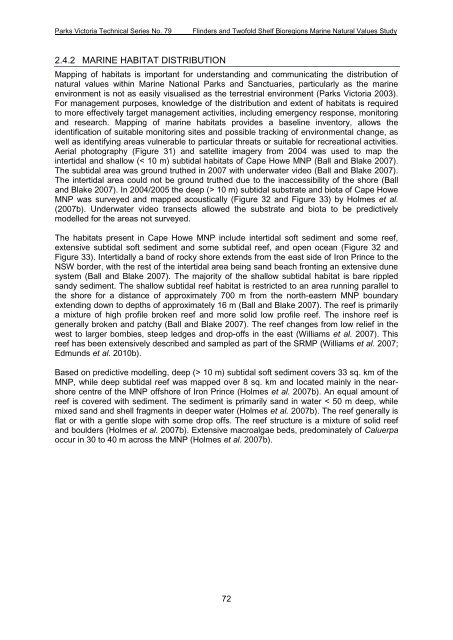parks victoria technical series marine natural values study vol 2 ...
parks victoria technical series marine natural values study vol 2 ...
parks victoria technical series marine natural values study vol 2 ...
You also want an ePaper? Increase the reach of your titles
YUMPU automatically turns print PDFs into web optimized ePapers that Google loves.
Parks Victoria Technical Series No. 79<br />
Flinders and Twofold Shelf Bioregions Marine Natural Values Study<br />
2.4.2 MARINE HABITAT DISTRIBUTION<br />
Mapping of habitats is important for understanding and communicating the distribution of<br />
<strong>natural</strong> <strong>values</strong> within Marine National Parks and Sanctuaries, particularly as the <strong>marine</strong><br />
environment is not as easily visualised as the terrestrial environment (Parks Victoria 2003).<br />
For management purposes, knowledge of the distribution and extent of habitats is required<br />
to more effectively target management activities, including emergency response, monitoring<br />
and research. Mapping of <strong>marine</strong> habitats provides a baseline inventory, allows the<br />
identification of suitable monitoring sites and possible tracking of environmental change, as<br />
well as identifying areas vulnerable to particular threats or suitable for recreational activities.<br />
Aerial photography (Figure 31) and satellite imagery from 2004 was used to map the<br />
intertidal and shallow (< 10 m) subtidal habitats of Cape Howe MNP (Ball and Blake 2007).<br />
The subtidal area was ground truthed in 2007 with underwater video (Ball and Blake 2007).<br />
The intertidal area could not be ground truthed due to the inaccessibility of the shore (Ball<br />
and Blake 2007). In 2004/2005 the deep (> 10 m) subtidal substrate and biota of Cape Howe<br />
MNP was surveyed and mapped acoustically (Figure 32 and Figure 33) by Holmes et al.<br />
(2007b). Underwater video transects allowed the substrate and biota to be predictively<br />
modelled for the areas not surveyed.<br />
The habitats present in Cape Howe MNP include intertidal soft sediment and some reef,<br />
extensive subtidal soft sediment and some subtidal reef, and open ocean (Figure 32 and<br />
Figure 33). Intertidally a band of rocky shore extends from the east side of Iron Prince to the<br />
NSW border, with the rest of the intertidal area being sand beach fronting an extensive dune<br />
system (Ball and Blake 2007). The majority of the shallow subtidal habitat is bare rippled<br />
sandy sediment. The shallow subtidal reef habitat is restricted to an area running parallel to<br />
the shore for a distance of approximately 700 m from the north-eastern MNP boundary<br />
extending down to depths of approximately 16 m (Ball and Blake 2007). The reef is primarily<br />
a mixture of high profile broken reef and more solid low profile reef. The inshore reef is<br />
generally broken and patchy (Ball and Blake 2007). The reef changes from low relief in the<br />
west to larger bombies, steep ledges and drop-offs in the east (Williams et al. 2007). This<br />
reef has been extensively described and sampled as part of the SRMP (Williams et al. 2007;<br />
Edmunds et al. 2010b).<br />
Based on predictive modelling, deep (> 10 m) subtidal soft sediment covers 33 sq. km of the<br />
MNP, while deep subtidal reef was mapped over 8 sq. km and located mainly in the nearshore<br />
centre of the MNP offshore of Iron Prince (Holmes et al. 2007b). An equal amount of<br />
reef is covered with sediment. The sediment is primarily sand in water < 50 m deep, while<br />
mixed sand and shell fragments in deeper water (Holmes et al. 2007b). The reef generally is<br />
flat or with a gentle slope with some drop offs. The reef structure is a mixture of solid reef<br />
and boulders (Holmes et al. 2007b). Extensive macroalgae beds, predominately of Caluerpa<br />
occur in 30 to 40 m across the MNP (Holmes et al. 2007b).<br />
72

















